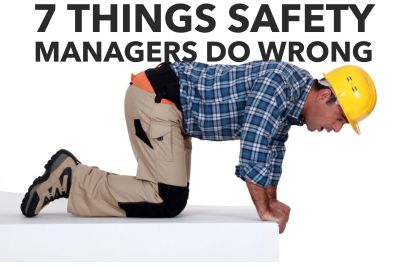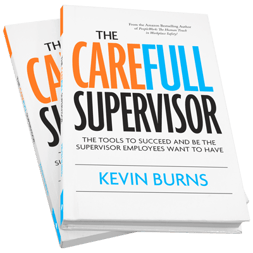The “management” part of safety management is as important as the “safety” part.
 It’s no surprise that safety managers spend a great deal of time staying current on safety legislation. In fact, they invest hours upon hours every month into ensuring they understand rules, processes and procedures for safety. What they don’t do though, is invest an equal amount of time in developing their management and communications skills. It is safety management after all. It’s two equal parts - safety and management.
It’s no surprise that safety managers spend a great deal of time staying current on safety legislation. In fact, they invest hours upon hours every month into ensuring they understand rules, processes and procedures for safety. What they don’t do though, is invest an equal amount of time in developing their management and communications skills. It is safety management after all. It’s two equal parts - safety and management.
As a result of little attention paid to the management side of skills development, here is a list of seven things that safety managers, supervisors, and advisors do wrong when it comes to managing the safety program and building respect with employees:
1Criticizes more than compliments. This is a huge de-motivator for employees. Being dumped on takes its toll after a while. Eventually, the voice of the safety guy gets tuned out. An article in the Harvard Business Review explained how for every negative comment made to an employee by a supervisor or manager, nearly six positive comments were needed to balance out the ratio. Criticizing is lazy. It takes no skill or experience to criticize. The work is in finding positives within the team.
2Unfamiliar with the “inspect, don’t expect” management philosophy. You’ve seen it happen at safety meetings. The safety manager goes over something once and just expects that everyone got it and understood it. But if it turns into an incident, the safety guy is quick to point out that he did cover it in the safety meeting. But he/she did not ensure that everyone not only heard it but understood it. In safety management, the key is to inspect what you expect. Then, follow-up. Again, and again.
3Quick to blame. This happens when “inspect, don’t expect” is ignored. Everyone else is to blame. After an incident, when managers use the Root Cause Analysis (RCA) to assess blame, they miss the point. RCA’s expose gaps in the safety program. Leaders share the blame when it goes wrong, but we’re not dealing with leaders here. We’re dealing with people in management positions without management skills. Blame is what people do when they lack self-confidence or are just plain arrogant. A safety manager’s blame can turnover staff, kill morale and contribute to a dwindling safety culture.
4Quicker to take the credit. When a poor manager fixes blame, he is willing to throw someone else under the bus. And just as easily, he can snatch the credit away from a team effort. That’s like an assistant coach taking credit for a sports team’s championship. It’s laughable. Safety performance isn’t tied to one person. It’s a shared celebration when it goes right and also when it doesn’t. But if a manager wants to know what it’s like to be universally despised, let him take the credit away from the team just once.
5Fancies himself a leader. But without the skills or the knowledge. Anyone who thinks that their safety certification automatically qualifies them as a leader is delusional. No one follows someone or respects them purely by their title. Leadership doesn’t come with your safety certification. In fact, many times, the opposite is true. Safety people are viewed cautiously - until they have earned acceptance as a quality person. You are in management - not leadership. Leadership is what you earn over time - by the person you are, not the position you hold.
6Blames senior management for lack of commitment. Openly articulating displeasure with senior management’s lack of commitment to safety and resources is a knife in the heart of safety culture. Sure, it’s nice to have more senior management support in safety. But it is not a requirement. Front-line employees can still make excellent safety decisions without more money from senior management. The safety person needs to build-up those safety values regardless of senior management’s level of commitment.
7Provides rules but no direction. He shouts about Zero harm goals but doesn’t provide forward-thinking, achievement strategies. Instead, he focuses on what happened yesterday, not about where we will be tomorrow. He peppers employees with gruesome photos, injury videos and a whole bunch of “don’t do this” messages. But there are no actual discussions of teamwork, inspiration or motivation. Just a lot of preaching about the rules, reviewing incident reports and lots of generic “we need to do better” without providing real strategies and direction on how to be better.
This list is in no way conclusive. There are a lot of other things that safety managers do that don’t get the desired results. But by looking at this list, you can see that the “management” part of safety management is as important as the “safety” part. For more, watch this video.
Kevin Burns is a management consultant, safety speaker and author of "The Perfect Safety Meeting" and his newest #1 Amazon Health & Safety Bestseller, "Running With Scissors - 10 Reasons To Invest in Safety In Slow Times." He is an expert in how to get through to people - how to talk with them so they hear and understand. Kevin's presentation "Trust The Process - Instill A Safety Attitude To Build An Engaged Culture Of Safety" will help your organization reach the following goals: better engagement and buy-in to safety, increased teamwork, better communication, lower turnover resulting in increased profits from production. Click here for more information and to discuss your needs with Kevin.


